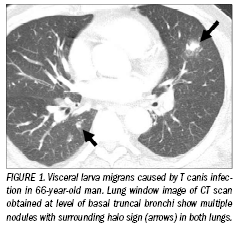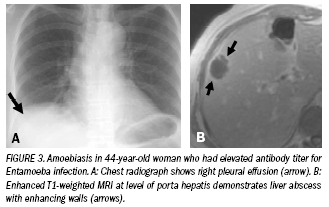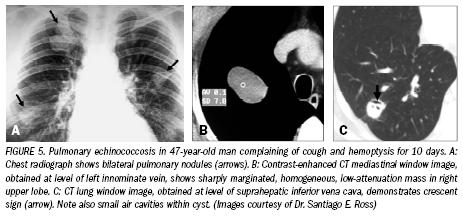Imaging provides answersin parasitic infections
Parasitic infections are endemic in developing countries located in tropical and subtropical regions.
Parasitic infections are endemic in developing countries located in tropical and subtropical regions. Risk of parasitic infection also extends to some groups in industrialized countries, including travelers, immigrants, institutionalized populations, and AIDS patients.1
Many parasitic infections that are common in Asian countries can lead to pulmonary lesions. These include toxocariasis, paragonimiasis, malaria, amebiasis, ascariasis, and strongyloidiasis.
Parasitic infection is one of the main causes of eosinophilia, which is defined as the presence of more than 500 eosinoph ils/L in peripheral blood. Eosinophilia may be accompanied by eosinophilic infiltration in tissue. Focal eosinophilic infiltration in the lungs and liver is relatively common and is often associated with a parasitic infection, drug hypersensitivity, allergic diseases, and collagen vascular diseases. It is also associated with internal malignancies such as Hodgkin's lymphoma as well as lung, stomach, pancreatic, or ovarian cancer.2
A finding of incidental peripheral eosinophilia may prompt further clinical workup in many patients with parasitic infections. Enzyme-linked immunosorbent assay (ELISA) for specific parasitic organisms (e. g., Paragonimus westermani or Toxocara canis) can help confirm a diagnosis of parasitic pulmonary infection.
• Toxocariasis (caused by the nematode Toxocara can is). T canis is the intestinal parasite of dogs, foxes, and other canids, and it is distributed worldwide. It is a main cause of so - called visceral larva migrans, the inflammatory reaction caused by migrating larvae of nematodes through the human viscera.3

Human infection with T canis occurs in two ways: ingestion of infective eggs in soil or eating of uncooked animal liver containing encapsulated larvae. The larvae are liberated in the intestine, penetrate the intestinal wall, flow through the portal vein, and reach the liver. They may stay in the liver or migrate to various organs, including the lungs, heart, eyes, and brain.4Toxocara larvae do not develop or grow in humans; they only migrate through viscera. Eggs or mature adults are not seen in human viscera.4 The small size of Toxocara larvae means that they are extremely difficult to identify from a microscopic examination, and diagnosis is typically made by ELISA.
Chest x-rays and CT scans show transient and migrating opacities. Single or multiple poorly defined nodules are seen, with or without a halo of ground-glass opacity (nodule with halo sign, Figure 1).
• Paragonimiasis (caused by flukes of the genus Paragonimus). Most cases of paragonimiasis are due to infection with Paragonimus westermani, an organism that is endemic in eastern and southeastern Asia, Latin America, and Africa. Approximately 20 million people in areas where P westermani is endemic are thought to be infected with the parasite.1
Human infection follows ingestion of undercooked crabs or crayfish infected with metacercaria, the infective stage of the parasite. The metacercaria excyst in the small intestine, and the larvae penetrate the intestinal wall and enter the peritoneal space. The larvae migrate through the diaphragm and pleura in three to eight weeks to the lungs, where they mature to adult flukes.5
Imaging findings of pulmonary paragonimias is depend on the stage of the disease, according to results from an animal study.6 Early findings, caused by the migration of juvenile worms, included pneumothorax or hydropneumothorax, focal consolidation, and localized pleural or fissural thickening. Linear opacities 2 to 4 mm thick and 3 to 7 cm long from the pleura were also seen. These may represent burrow tracts. Late findings resulted from worm cysts and their related surrounding lung parenchymal changes. These included thin-walled cysts, masslike consolidation, nodules, and bronchiectasis.
The most common radiographic findings of pleuropulmonary paragonimiasis in human clinical studies include patchy consolidation, with or without cavity formation, and peripheral linear opacities. 7,8 Pleural effusions or pneumothoraces are also common. CT often shows subpleural or subfissural nodules or focal consolidation with a low - attenuation necrotic area or an air- filled cavity (Figure 2). Peripheral linear opacity connecting the pleura with a necrotic peripheral pulmonary nodule is also common on CT.
• Human malaria (caused by Plasmodium species). Malaria affects an estimated 400 to 490 million people and results in 2.2 to 2.5 million deaths annually. 9 It is endemic in South America, Africa, and southern Asia. The P falciparum, P vivax, Povale, and P malariae parasites that cause human malaria are transmitted by mosquito. Sporozoites are transferred from the mosquito to humans, where they move to the hepatocytes. Merozoites released from the liver invade the erythrocytes, causing them to rupture.1
The most common imaging manifestation of malaria is nonhydrostatic or noncardiogenic pulmonary edema, resulting from increased pulmonary capillary permeability and leading to acute respiratory distress syndrome. This condition has been well described in P falciparum malaria. Although the overall risk of developing pulmonary edema in P falciparum infection is low, it is a common feature in patients with severe and complicated malaria. P viva x and P ovale occasionally result in nonhydrostatic pulmonary edema as well.10
Less typical radiological findings include interstitial edema, pleural effusions, and consolidation. These are usually associated with benign forms of malarial infection. 11 Cryptogenic organizing pneumonia and eosinophilic pneumonia have been reported as well.1
• Amebiasis (protozoan infection caused by Entamoeba histolytica). Amebiasis is the third most common cause of death among parasitic infections after malaria and schistosomiasis. It is thought to affect approximately 1% of the world's population, causing 40,000 to 110,000 deaths every year.1 It has a worldwide distribution and is found frequently among people of lower socioeconomic classes.12
Human infection follows ingestion of amebiccysts in fecally contaminated water or food. The amebic cysts and trophozoites are released in the small intestine. The trophozoites multiply in the colon, and reencystation occurs. The cysts are passed in the feces and may be ingested by another host. Sometimes trophozoites invade the colon wall, causing a condition known as amebic dysentery. They may also enter the mesenteric veins, move to the liver, and cause amebic liver abscess.13
Although the intestine is the primary site of Entamoeba infection, mortal ity depends primarily on extraintestinal involvement. Pleuropulmonary involvement is the second most common imaging manifestation in cases of extraintestinal amebias is. This usually occurs in association with liver abscess, which is the most common imaging finding.12,13

Common radiographic findings include elevation of the right hemi diaphragm, pulmonary infiltrates or atelectas is in the basal lungs, and pleural effusions (Figure 3). Pulmonary parenchymal opacities and pleural effusions are usually seen in the right lower lung zone, though left side manifestation may also be seen. Pleural effusion is caused by an inflammatory reaction and is consequently sterile, though it can become empyemic if the liver abscess ruptures into the pleural space. Lung abscesses can be produced when a liver abscess ruptures to the lung. Chest x-ray may show an airfilled cavity, with or without air-fluid level.
CT offers improved visualization of lung abscesses and pleural effusion. The modality also allows assessment of liver abscesses and their extension across the diaphragm into the pleura or lung. CT may demonstr ate he patobronchial or bronchobiliary fistula, which are known complications of amebic liver abscess.12-15
• Ascariasis (caused by the nematode Ascaris lumbricoides). Ascarias is is one of the most common parasitic infections, affecting 1.3 billion people and causing approximately 1550 deaths annually.16 Infection is caused by ingestion of Ascaris eggs in food or water. Larvae released from eggs in the small intestine migrate to the lungs, whe re they mature and destroy capillaries and alveolar walls. They are then coughed up and swallowed, and they reach the small intestine once more. There they develop into adult worms.1,15
Chest radiography and CT show migratory, patchy airspace opacities that typically resolve within 10 days. Lobar consolidation and alveolar hemorrhage have also been described.1
• Strongyloidiasis (caused by the microscopic nematode Strongyloides stercoralis). S stercoralis is found in all tropical and subtropical regions. Approximately 35 million people worldwide are infected with the parasitic nematod e. S stercoralis can replicate within humans (autoinfection), unlike other helminthic parasites. Infective filariform larvae in soil penetrate intact human skin , enter the circulatory system, and reach the lungs, where they penetrate the capillary walls into alveolar spaces. The larvae are coughed up to the pharynx and swallowed. Adult worms develop in the small intestine and produce eggs. Rhabditi form larvae hatched from the eggs are either excreted in stool or become filariform larvae in the colon, migrate to the lungs, and then follow the previously described life cycle. Continuous autoinfection can cause massive and disseminated parasitic infection (hyperinfection syndrome), especially in immunocompromised hosts.1,17

Most patients with respiratory symptoms and signs of strongyloidiasis have abnormal radiographic findings. Chest radiography demonstrates poorly marginated, patchy airspace opacities. Serial chest x-rays may show signs of migration (Figure 4), and pleural effusions can be seen as well, more commonly in patients with hyperinfection syndrome.
CT shows patchy ground-glass opacities and focal ai rspace consolidation without any zonal predominance. Extensive bilateral ground-glass opacities and consolidation can be seen in patients with hyperinfection syndrome (Figure 4), which may result in acute respiratory distress syndrome. Cavitation and abscess formation, which are usually associated with superimposed bacterial infection, may also occur.1,15,18
Transient and migrating opacities on imaging studies and peripheral blood or tissue eosinophilia should raise the suspicion of parasitic infection. ELISA or bronchoalveolar lavage fluid analyses can help confirm the diagnosis. Massive parasitic infection may occur in immunocompromised hosts.
• Echinococcosis/ hydatid disease (caused by Echinococcus larvae, not adult worms). The majority of human infections are caused by E granulosus, which is endemic in the Middle East, Australia, New Zealand, Mediterranean regions, South America, and some sub-Saharan countries. 1,19,20 Both intermediate and final hosts are required for the completion of the life cycle. Echinococcus eggs become larvae in intermediate hosts (humans and mainly domestic animals such as cattle, horses, pigs, or sheep). The larvae then grow into adult worms in canines (mainly dogs), which are their final hosts. Adult worms parasitize in the small intestine of their canine hosts. Eggs are produced that are passed in feces and ingested by intermediate hosts, including humans.19,20
Eggs ingested by humans travel to the small intestine where they produce larvae, which enter the portal system through the intestinal wall. Most larvae in the circulatory system are trapped in the liver or the lungs, owing to the presence of capillary beds in those organs. They subsequently develop into spherical or oval hydatid cysts, with diameters ranging from 1 to 20 cm. The cyst walls consist of three layers: endocyst, exocyst, and host - produced pericyst. Hydatid cysts contain fluid and many protoscolices, from which daughter cysts may develop.1,15,19,20
Hydatid cysts appear as sharply marginated spherical or oval nodules or masses on chest radiography. The cysts are multiple in 40% of patients and bilateral in 20%. Communication between the cyst and the airway is seen as a crescent sign (air between pericyst and exocyst) or an air-fluid level.

CT demonstrates hydatid cysts as homogeneous, well-circumscribed masses of water attenuati on (Figure 5). The cyst wall enhances after injection of intravenous contrast. A detached endocyst, collapsed daughter cyst membrane, and/or intact daughter cyst is considered a pathognomonic finding of ruptured or complicated hydatid cysts. These are visualized better on CT than radiography. Parenchymal consolidations may be associated with cyst rupture.1,15,21,22
In conclusion, the imaging features of parasitic pulmonary infection are diverse and dependent on the causative organisms involved. The transient and migratory nature of lung lesions on serial imaging and the presence of peripheral blood or tissue eosinophilia may suggest the presence of parasitic pulmonary infection. A specific ELISA for each organism and bronchoalveolar lavage fluid analysis may help diagnose parasitic infection. Severe infection of strongyloidiasis, especially in immunocompromised patients, can cause adult respiratory distress syndrome.
Assisting in the preparation of this manuscript were Dr. Tae Sung Kim, Dr. Myung Jin Chung, and Dr. Chin A. Yi, also from the department of radiology and ce nter for imaging sc ie nce, Sam sung Medical Cente r, Sung kyunkwan University School of Medicine.
What New Research Reveals About Novice Use of AI-Guided Cardiac Ultrasound
April 4th 2025In a study recently presented at the American College of Cardiology (ACC) conference, researchers found that novice use of AI-guided cardiac ultrasound after an AI-enabled electrocardiogram increased the positive predictive value for reduced left ventricular ejection fraction (LVEF) or aortic valve stenosis by 33 percent.
The Reading Room Podcast: Current Perspectives on the Updated Appropriate Use Criteria for Brain PET
March 18th 2025In a new podcast, Satoshi Minoshima, M.D., Ph.D., and James Williams, Ph.D., share their insights on the recently updated appropriate use criteria for amyloid PET and tau PET in patients with mild cognitive impairment.
Study with CT Data Suggests Women with PE Have More Than Triple the One-Year Mortality Rate than Men
April 3rd 2025After a multivariable assessment including age and comorbidities, women with pulmonary embolism (PE) had a 48 percent higher risk of one-year mortality than men with PE, according to a new study involving over 33,000 patients.
GE HealthCare Debuts AI-Powered Cardiac CT Device at ACC Conference
April 1st 2025Featuring enhanced low-dose image quality with motion-free images, the Revolution Vibe CT system reportedly facilitates improved diagnostic clarity for patients with conditions ranging from in-stent restenosis to atrial fibrillation.